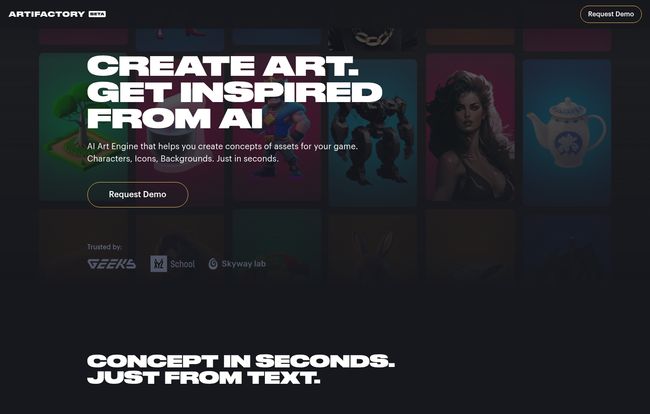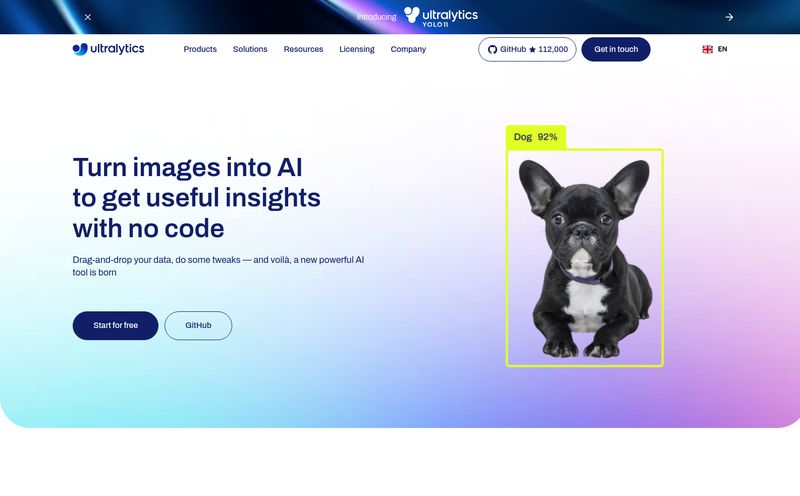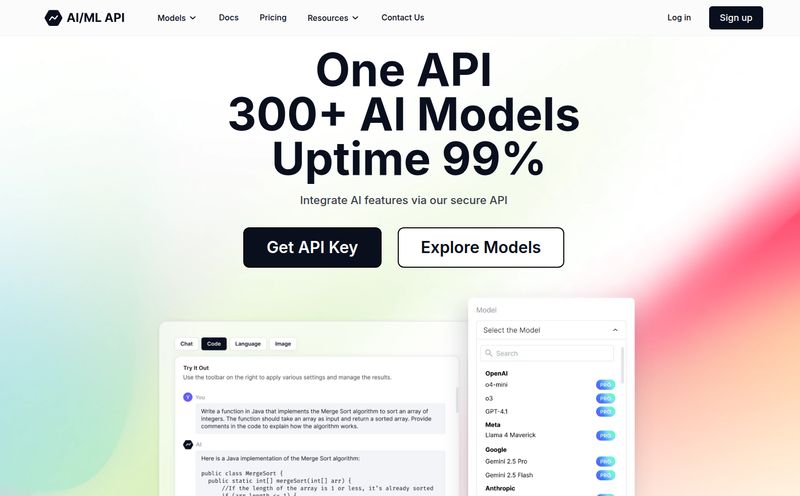The AI art world is a bit of a Wild West right now, isn't it? Every week there’s a new model, a new platform, a new controversy. As someone who’s spent years neck-deep in digital trends, I’ve seen these gold rushes before. And while platforms like Midjourney are fantastic for churning out surreal dreamscapes, they often leave professional creators—especially game developers—with a nagging question: Who actually owns this stuff?
It’s a serious problem. You spend hours crafting the perfect prompt to generate a character concept for your next indie hit, only to get lost in the murky depths of a Terms of Service agreement. Is it yours? Is it theirs? Can you commercially use it without limitation? It's enough to make you want to go back to sketching on napkins.
That's why when I stumbled upon a tool called Artifactory, my curiosity was definitely piqued. It's not trying to be the everything-for-everyone AI. Instead, it’s laser-focused on one thing: helping game developers create concepts for their assets. Characters, icons, environments, you name it. And it tackles the ownership question head-on.
So, What Exactly is Artifactory?
At its core, Artifactory is a cloud-hosted AI art engine running on Stable Diffusion. Think of it as your own private, high-powered Stable Diffusion setup in the cloud, without the headache of installing CUDA drivers and wrestling with Python dependencies on your own machine. We’ve all been there.
The entire platform is designed for a game development workflow. You need a set of 2D icons for an RPG inventory? Describe them. You need to visualize a new enemy character? Give it a prompt. You need a dozen variations of a sci-fi background? It’s built for that. They even have some big names listed as clients, like Voodoo and Mamboo Games, so it’s clearly being put to the test in real-world studios.

Visit Artifactory – AI Game Assets Generation
How It Works: The Three-Step Dance
Getting started seems refreshingly simple. There’s no complex dashboard to learn, just a straightforward process.
- Setup Session: First, you rent a server for the hour and choose your weapon—a powerful GPU like an RTX 3090 or even a mighty A100. This is for the serious creator who needs raw power.
- Wait a Few Minutes: Here’s a dose of reality. The server needs to spin up, which can take up to five minutes. This isn't instant ramen. Go grab a coffee, check your email, and let the magic happen behind the scenes.
- Generate Images: Once it's running, you’re in. You can start creating images from text prompts, use existing images as references, or load up custom models you’ve trained. The generation itself happens in seconds.
The Features That Actually Matter to Creators
Okay, lots of tools can generate images. But Artifactory has a few core tenets that made me sit up and pay attention. These aren’t just features; they’re philosophies.
You Own It. All Of It. (Yes, Really)
This is the big one. According to their site, you have full intellectual property rights over the images you generate and the models you train. For a game developer, those words are more beautiful than a perfectly rendered sunset over a fantasy kingdom. It means the assets are yours. The style you develop is yours. You can build a brand on it, sell your game, and sleep at night without worrying about a legal letter showing up one day. This single point puts Artifactory in a completely different category from many mainstream generators.
Your Art Doesn't Live on Their Servers
Privacy is another huge win. Artifactory states that they don't store your models or your images by default. When your session ends, your files are deleted. This is like the difference between painting in a private, locked studio versus painting in a public square. For studios working on unannounced projects, this is a non-negotiable feature. No risk of your concept art leaking or being used to train some future global model.
No Vendor Lock-In: The Open-Source Ace Up Its Sleeve
The platform seem to be built around open-source projects like Stable Diffusion and AUTOMATIC1111's popular web UI. Why is this brilliant? Because it means you're not learning a proprietary, closed-off system. The skills you hone in prompting and model training are transferable. If Artifactory were to disappear tomorrow (I hope not!), your knowledge wouldn't become obsolete. You're investing in your own skills, not just in their platform.
Advanced Tools for the Serious Artist
This isn't just a simple text-to-image box. The platform gives you access to the powerful tools that the hardcore AI art community loves. You can fine-tune models using techniques like Dreambooth, Textual Inversion, and Hypernetworks. This is how you go from generic AI art to your art.
Want to create a game with a unique, consistent main character? Train a model on your own concept sketches using Dreambooth. Need to inject a specific object or style? That's what Textual Inversion is for. It also has the essentials, like upscaling to increase resolution and the ability to use an image as a starting point (often called img2img), which is perfect for iterating on an idea.
The Elephant in the Room: What’s This Going to Cost Me?
Alright, so what’s the catch? Usually, it's the price. With Artifactory, it’s a little… mysterious. Their model is based on renting a server by the hour. This makes sense—you're paying for dedicated, high-performance hardware (those A100s don't pay for themselves).
However, when I went looking for a pricing page, I was greeted by a friendly "404 Page not found" error. This, combined with the "Request Demo" button and the "Consulting & Support" offering, tells me Artifactory is likely targeting professional studios and enterprise clients rather than the casual hobbyist. It's less like a cheap subscription service and more like a professional-grade rental. You probably need to talk to them to get a quote, which might be a barrier for a solo indie dev on a shoestring budget.
Is Artifactory the Right Tool for Your Studio?
After digging in, I think I have a pretty good feel for who this is for. If you're a solo developer or a small studio that’s serious about creating a unique and consistent visual style that you own, Artifactory is incredibly compelling. The combination of IP ownership, privacy, and the power of a dedicated Stable Diffusion environment is a potent mix. It's like renting a professional art workshop instead of using a public crafting table; it costs more and takes a moment to set up, but the control and ownership are absolute.
On the flip side, if you're just looking to generate a few fun images for a mood board or a D&D campaign, the hourly rental model and the five-minute startup time might be overkill. This is a pro tool for pros, and it’s positioned that way.
Frequently Asked Questions about Artifactory
- Do I own the art I create with Artifactory?
- Yes. Artifactory is very clear that users retain full intellectual property rights over both the images they generate and any models they train on the platform.
- What is Artifactory built on?
- It's a cloud-hosted service that leverages powerful open-source tools, most notably Stable Diffusion. This means you're not locked into a proprietary ecosystem.
- Is Artifactory good for beginners?
- While the process is straightforward, the feature set (like model training and GPU selection) and pricing model are geared more towards professional users, like game development studios, who have some familiarity with AI art concepts.
- How does Artifactory's pricing work?
- It's based on an hourly rental of a cloud server with a high-end GPU. Specific prices aren't listed on the site; you'll likely need to request a demo or contact them for a quote, which suggests a focus on B2B clients.
- Does Artifactory store my images or models?
- No. A key feature is privacy. All your generated images and trained models are deleted from their servers when your session ends.
- Can I train the AI on my own art style?
- Absolutely. The platform supports advanced training methods like Dreambooth, Textual Inversion, and Hypernetworks, allowing you to fine-tune the AI to generate assets in your specific, consistent style.
Final Thoughts from a Fellow Digital Digger
In a sea of AI image generators, Artifactory has chosen a very specific hill to die on: creator ownership and privacy. And frankly, it's the right hill. For too long, the professional creative community has been cautious about AI tools precisely because of these ambiguities.
Artifactory isn't just offering a service; it's offering peace of mind. It’s a tool that respects the user's work and their intellectual property. While the barrier to entry might be a bit higher than your average app, for the right user—the game studio, the freelance concept artist, the serious creator—it could be the missing piece of the puzzle for integrating AI into a professional workflow. It's a serious tool, for serious work. And in this crazy, fast-moving space, that's incredibly refreshing to see.
Reference and Sources
- Artifactory Official Website: artifactory.ai
- Stability AI (Creators of Stable Diffusion): stability.ai
- Dreambooth Paper (for the technically curious): dreambooth.github.io



